Zixiang Zhao
C-Flat++: Towards a More Efficient and Powerful Framework for Continual Learning
Aug 26, 2025Abstract:Balancing sensitivity to new tasks and stability for retaining past knowledge is crucial in continual learning (CL). Recently, sharpness-aware minimization has proven effective in transfer learning and has also been adopted in continual learning (CL) to improve memory retention and learning efficiency. However, relying on zeroth-order sharpness alone may favor sharper minima over flatter ones in certain settings, leading to less robust and potentially suboptimal solutions. In this paper, we propose \textbf{C}ontinual \textbf{Flat}ness (\textbf{C-Flat}), a method that promotes flatter loss landscapes tailored for CL. C-Flat offers plug-and-play compatibility, enabling easy integration with minimal modifications to the code pipeline. Besides, we present a general framework that integrates C-Flat into all major CL paradigms and conduct comprehensive comparisons with loss-minima optimizers and flat-minima-based CL methods. Our results show that C-Flat consistently improves performance across a wide range of settings. In addition, we introduce C-Flat++, an efficient yet effective framework that leverages selective flatness-driven promotion, significantly reducing the update cost required by C-Flat. Extensive experiments across multiple CL methods, datasets, and scenarios demonstrate the effectiveness and efficiency of our proposed approaches. Code is available at https://github.com/WanNaa/C-Flat.
Towards Understanding The Calibration Benefits of Sharpness-Aware Minimization
May 29, 2025Abstract:Deep neural networks have been increasingly used in safety-critical applications such as medical diagnosis and autonomous driving. However, many studies suggest that they are prone to being poorly calibrated and have a propensity for overconfidence, which may have disastrous consequences. In this paper, unlike standard training such as stochastic gradient descent, we show that the recently proposed sharpness-aware minimization (SAM) counteracts this tendency towards overconfidence. The theoretical analysis suggests that SAM allows us to learn models that are already well-calibrated by implicitly maximizing the entropy of the predictive distribution. Inspired by this finding, we further propose a variant of SAM, coined as CSAM, to ameliorate model calibration. Extensive experiments on various datasets, including ImageNet-1K, demonstrate the benefits of SAM in reducing calibration error. Meanwhile, CSAM performs even better than SAM and consistently achieves lower calibration error than other approaches
Q-VDiT: Towards Accurate Quantization and Distillation of Video-Generation Diffusion Transformers
May 28, 2025Abstract:Diffusion transformers (DiT) have demonstrated exceptional performance in video generation. However, their large number of parameters and high computational complexity limit their deployment on edge devices. Quantization can reduce storage requirements and accelerate inference by lowering the bit-width of model parameters. Yet, existing quantization methods for image generation models do not generalize well to video generation tasks. We identify two primary challenges: the loss of information during quantization and the misalignment between optimization objectives and the unique requirements of video generation. To address these challenges, we present Q-VDiT, a quantization framework specifically designed for video DiT models. From the quantization perspective, we propose the Token-aware Quantization Estimator (TQE), which compensates for quantization errors in both the token and feature dimensions. From the optimization perspective, we introduce Temporal Maintenance Distillation (TMD), which preserves the spatiotemporal correlations between frames and enables the optimization of each frame with respect to the overall video context. Our W3A6 Q-VDiT achieves a scene consistency of 23.40, setting a new benchmark and outperforming current state-of-the-art quantization methods by 1.9$\times$. Code will be available at https://github.com/cantbebetter2/Q-VDiT.
A Unified Solution to Video Fusion: From Multi-Frame Learning to Benchmarking
May 26, 2025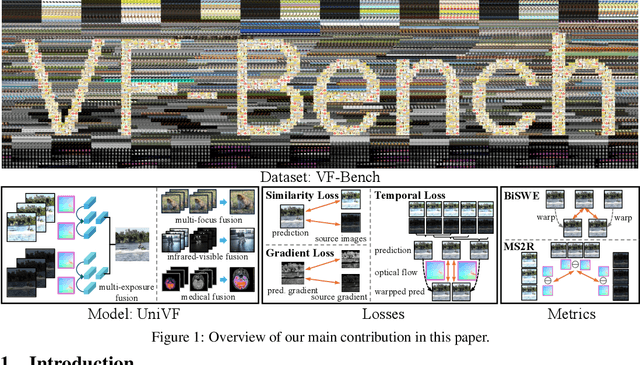

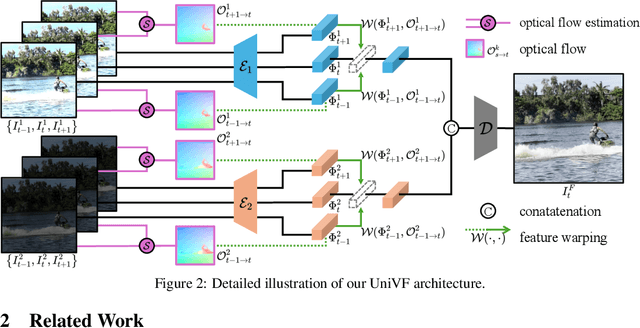

Abstract:The real world is dynamic, yet most image fusion methods process static frames independently, ignoring temporal correlations in videos and leading to flickering and temporal inconsistency. To address this, we propose Unified Video Fusion (UniVF), a novel framework for temporally coherent video fusion that leverages multi-frame learning and optical flow-based feature warping for informative, temporally coherent video fusion. To support its development, we also introduce Video Fusion Benchmark (VF-Bench), the first comprehensive benchmark covering four video fusion tasks: multi-exposure, multi-focus, infrared-visible, and medical fusion. VF-Bench provides high-quality, well-aligned video pairs obtained through synthetic data generation and rigorous curation from existing datasets, with a unified evaluation protocol that jointly assesses the spatial quality and temporal consistency of video fusion. Extensive experiments show that UniVF achieves state-of-the-art results across all tasks on VF-Bench. Project page: https://vfbench.github.io.
RefComp: A Reference-guided Unified Framework for Unpaired Point Cloud Completion
Apr 18, 2025Abstract:The unpaired point cloud completion task aims to complete a partial point cloud by using models trained with no ground truth. Existing unpaired point cloud completion methods are class-aware, i.e., a separate model is needed for each object class. Since they have limited generalization capabilities, these methods perform poorly in real-world scenarios when confronted with a wide range of point clouds of generic 3D objects. In this paper, we propose a novel unpaired point cloud completion framework, namely the Reference-guided Completion (RefComp) framework, which attains strong performance in both the class-aware and class-agnostic training settings. The RefComp framework transforms the unpaired completion problem into a shape translation problem, which is solved in the latent feature space of the partial point clouds. To this end, we introduce the use of partial-complete point cloud pairs, which are retrieved by using the partial point cloud to be completed as a template. These point cloud pairs are used as reference data to guide the completion process. Our RefComp framework uses a reference branch and a target branch with shared parameters for shape fusion and shape translation via a Latent Shape Fusion Module (LSFM) to enhance the structural features along the completion pipeline. Extensive experiments demonstrate that the RefComp framework achieves not only state-of-the-art performance in the class-aware training setting but also competitive results in the class-agnostic training setting on both virtual scans and real-world datasets.
Retinex-MEF: Retinex-based Glare Effects Aware Unsupervised Multi-Exposure Image Fusion
Mar 10, 2025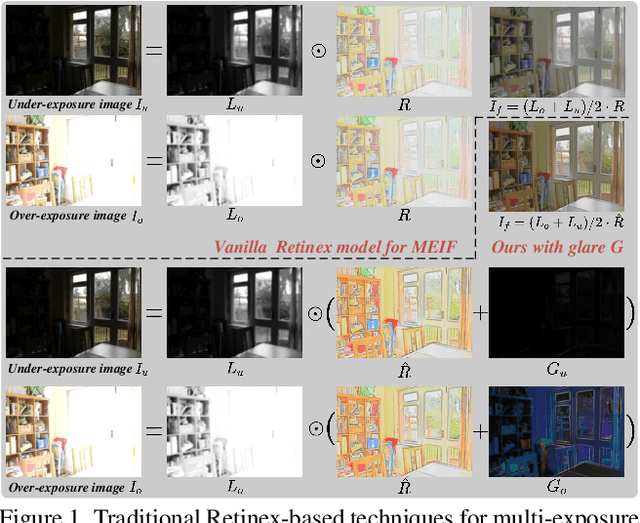
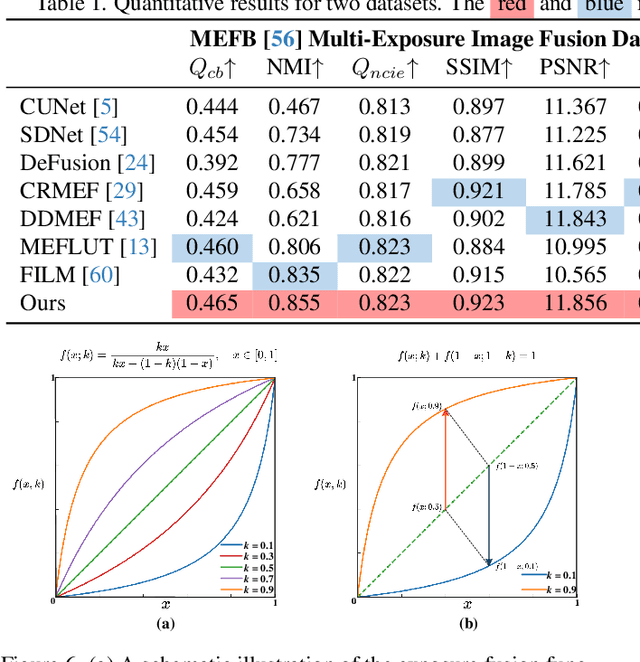

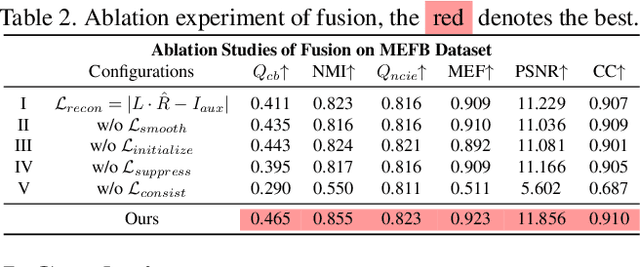
Abstract:Multi-exposure image fusion consolidates multiple low dynamic range images of the same scene into a singular high dynamic range image. Retinex theory, which separates image illumination from scene reflectance, is naturally adopted to ensure consistent scene representation and effective information fusion across varied exposure levels. However, the conventional pixel-wise multiplication of illumination and reflectance inadequately models the glare effect induced by overexposure. To better adapt this theory for multi-exposure image fusion, we introduce an unsupervised and controllable method termed~\textbf{(Retinex-MEF)}. Specifically, our method decomposes multi-exposure images into separate illumination components and a shared reflectance component, and effectively modeling the glare induced by overexposure. Employing a bidirectional loss constraint to learn the common reflectance component, our approach effectively mitigates the glare effect. Furthermore, we establish a controllable exposure fusion criterion, enabling global exposure adjustments while preserving contrast, thus overcoming the constraints of fixed-level fusion. A series of experiments across multiple datasets, including underexposure-overexposure fusion, exposure control fusion, and homogeneous extreme exposure fusion, demonstrate the effective decomposition and flexible fusion capability of our model.
Simultaneous Automatic Picking and Manual Picking Refinement for First-Break
Feb 03, 2025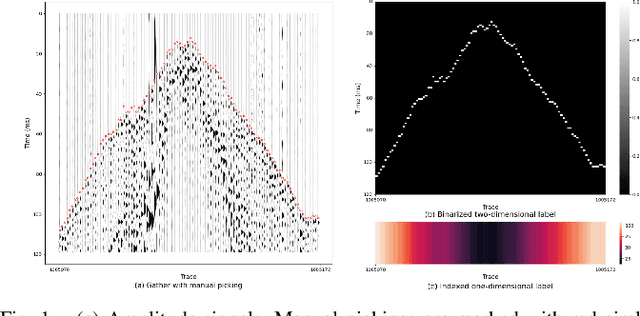
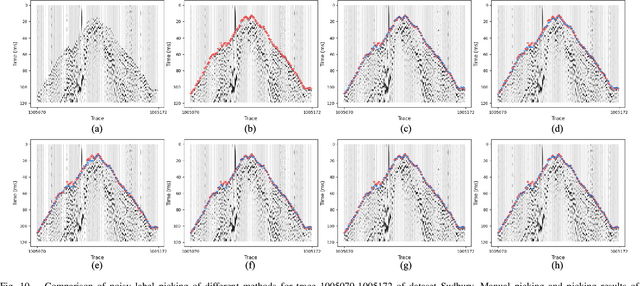
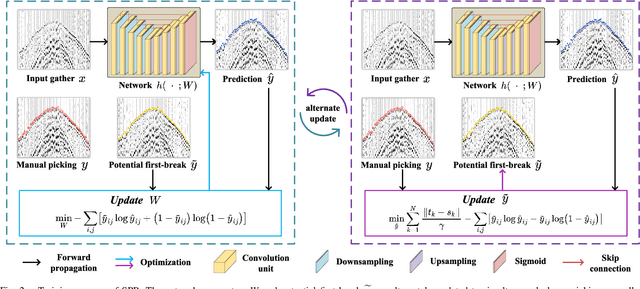
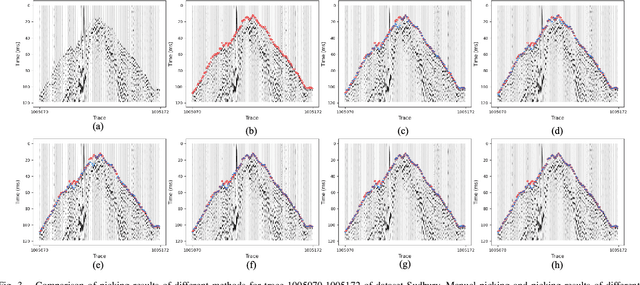
Abstract:First-break picking is a pivotal procedure in processing microseismic data for geophysics and resource exploration. Recent advancements in deep learning have catalyzed the evolution of automated methods for identifying first-break. Nevertheless, the complexity of seismic data acquisition and the requirement for detailed, expert-driven labeling often result in outliers and potential mislabeling within manually labeled datasets. These issues can negatively affect the training of neural networks, necessitating algorithms that handle outliers or mislabeled data effectively. We introduce the Simultaneous Picking and Refinement (SPR) algorithm, designed to handle datasets plagued by outlier samples or even noisy labels. Unlike conventional approaches that regard manual picks as ground truth, our method treats the true first-break as a latent variable within a probabilistic model that includes a first-break labeling prior. SPR aims to uncover this variable, enabling dynamic adjustments and improved accuracy across the dataset. This strategy mitigates the impact of outliers or inaccuracies in manual labels. Intra-site picking experiments and cross-site generalization experiments on publicly available data confirm our method's performance in identifying first-break and its generalization across different sites. Additionally, our investigations into noisy signals and labels underscore SPR's resilience to both types of noise and its capability to refine misaligned manual annotations. Moreover, the flexibility of SPR, not being limited to any single network architecture, enhances its adaptability across various deep learning-based picking methods. Focusing on learning from data that may contain outliers or partial inaccuracies, SPR provides a robust solution to some of the principal obstacles in automatic first-break picking.
Deep Unfolding Multi-modal Image Fusion Network via Attribution Analysis
Feb 03, 2025
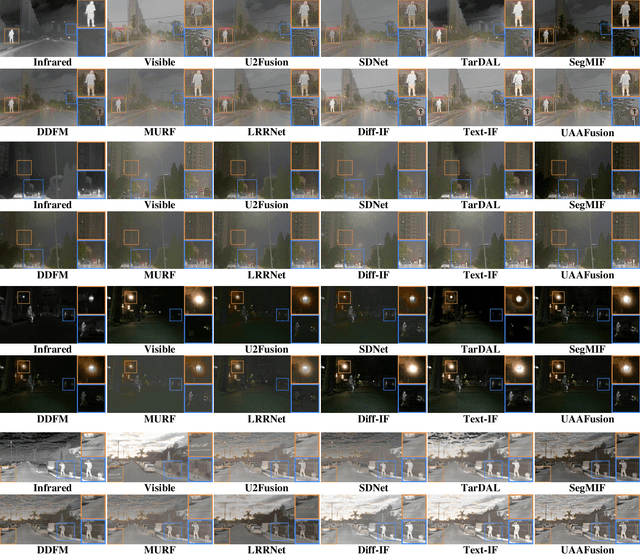
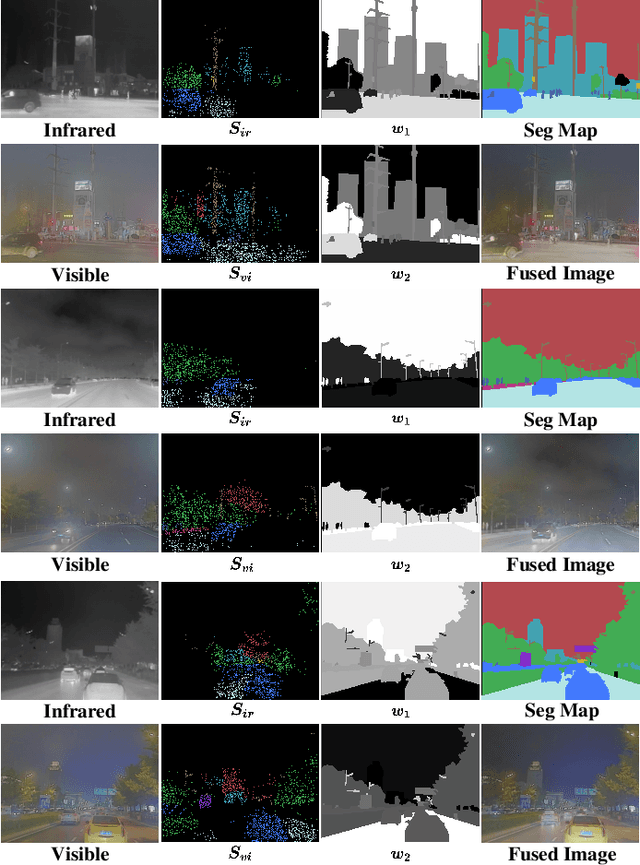
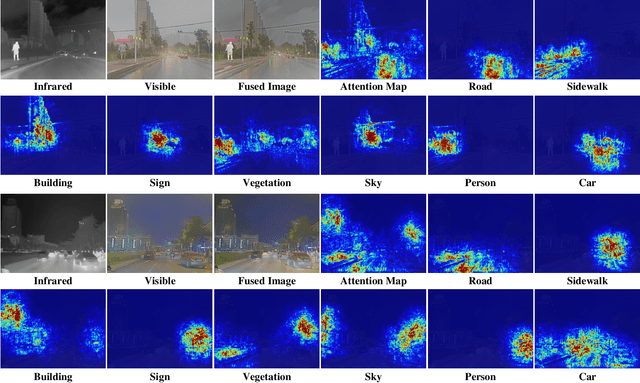
Abstract:Multi-modal image fusion synthesizes information from multiple sources into a single image, facilitating downstream tasks such as semantic segmentation. Current approaches primarily focus on acquiring informative fusion images at the visual display stratum through intricate mappings. Although some approaches attempt to jointly optimize image fusion and downstream tasks, these efforts often lack direct guidance or interaction, serving only to assist with a predefined fusion loss. To address this, we propose an ``Unfolding Attribution Analysis Fusion network'' (UAAFusion), using attribution analysis to tailor fused images more effectively for semantic segmentation, enhancing the interaction between the fusion and segmentation. Specifically, we utilize attribution analysis techniques to explore the contributions of semantic regions in the source images to task discrimination. At the same time, our fusion algorithm incorporates more beneficial features from the source images, thereby allowing the segmentation to guide the fusion process. Our method constructs a model-driven unfolding network that uses optimization objectives derived from attribution analysis, with an attribution fusion loss calculated from the current state of the segmentation network. We also develop a new pathway function for attribution analysis, specifically tailored to the fusion tasks in our unfolding network. An attribution attention mechanism is integrated at each network stage, allowing the fusion network to prioritize areas and pixels crucial for high-level recognition tasks. Additionally, to mitigate the information loss in traditional unfolding networks, a memory augmentation module is incorporated into our network to improve the information flow across various network layers. Extensive experiments demonstrate our method's superiority in image fusion and applicability to semantic segmentation.
Hipandas: Hyperspectral Image Joint Denoising and Super-Resolution by Image Fusion with the Panchromatic Image
Dec 05, 2024



Abstract:Hyperspectral images (HSIs) are frequently noisy and of low resolution due to the constraints of imaging devices. Recently launched satellites can concurrently acquire HSIs and panchromatic (PAN) images, enabling the restoration of HSIs to generate clean and high-resolution imagery through fusing PAN images for denoising and super-resolution. However, previous studies treated these two tasks as independent processes, resulting in accumulated errors. This paper introduces \textbf{H}yperspectral \textbf{I}mage Joint \textbf{Pand}enoising \textbf{a}nd Pan\textbf{s}harpening (Hipandas), a novel learning paradigm that reconstructs HRHS images from noisy low-resolution HSIs (LRHS) and high-resolution PAN images. The proposed zero-shot Hipandas framework consists of a guided denoising network, a guided super-resolution network, and a PAN reconstruction network, utilizing an HSI low-rank prior and a newly introduced detail-oriented low-rank prior. The interconnection of these networks complicates the training process, necessitating a two-stage training strategy to ensure effective training. Experimental results on both simulated and real-world datasets indicate that the proposed method surpasses state-of-the-art algorithms, yielding more accurate and visually pleasing HRHS images.
Task-driven Image Fusion with Learnable Fusion Loss
Dec 04, 2024Abstract:Multi-modal image fusion aggregates information from multiple sensor sources, achieving superior visual quality and perceptual characteristics compared to any single source, often enhancing downstream tasks. However, current fusion methods for downstream tasks still use predefined fusion objectives that potentially mismatch the downstream tasks, limiting adaptive guidance and reducing model flexibility. To address this, we propose Task-driven Image Fusion (TDFusion), a fusion framework incorporating a learnable fusion loss guided by task loss. Specifically, our fusion loss includes learnable parameters modeled by a neural network called the loss generation module. This module is supervised by the loss of downstream tasks in a meta-learning manner. The learning objective is to minimize the task loss of the fused images, once the fusion module has been optimized by the fusion loss. Iterative updates between the fusion module and the loss module ensure that the fusion network evolves toward minimizing task loss, guiding the fusion process toward the task objectives. TDFusion's training relies solely on the loss of downstream tasks, making it adaptable to any specific task. It can be applied to any architecture of fusion and task networks. Experiments demonstrate TDFusion's performance in both fusion and task-related applications, including four public fusion datasets, semantic segmentation, and object detection. The code will be released.
 Add to Chrome
Add to Chrome Add to Firefox
Add to Firefox Add to Edge
Add to Edge